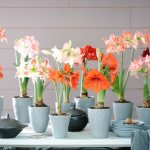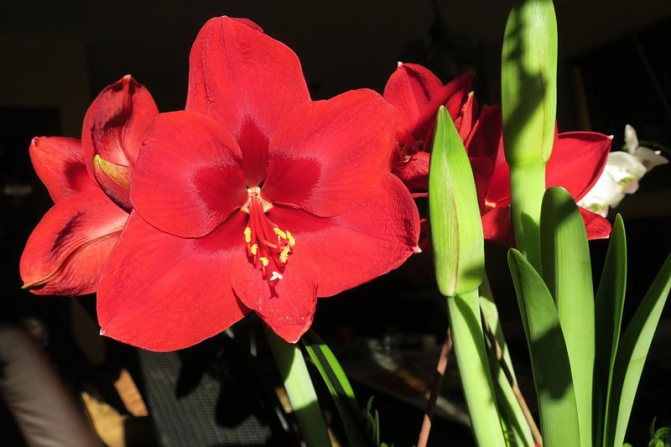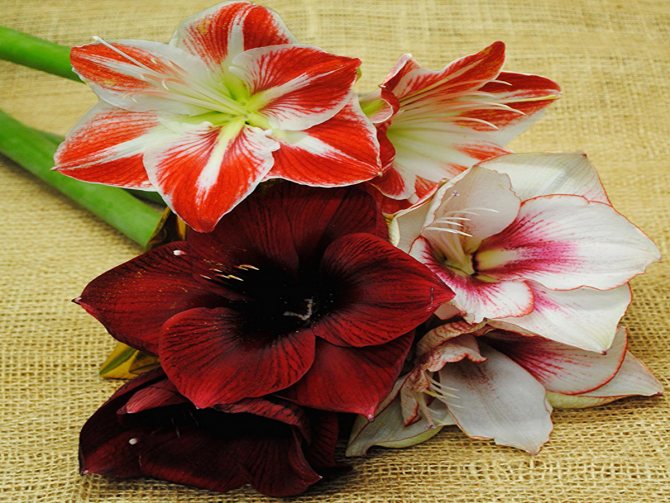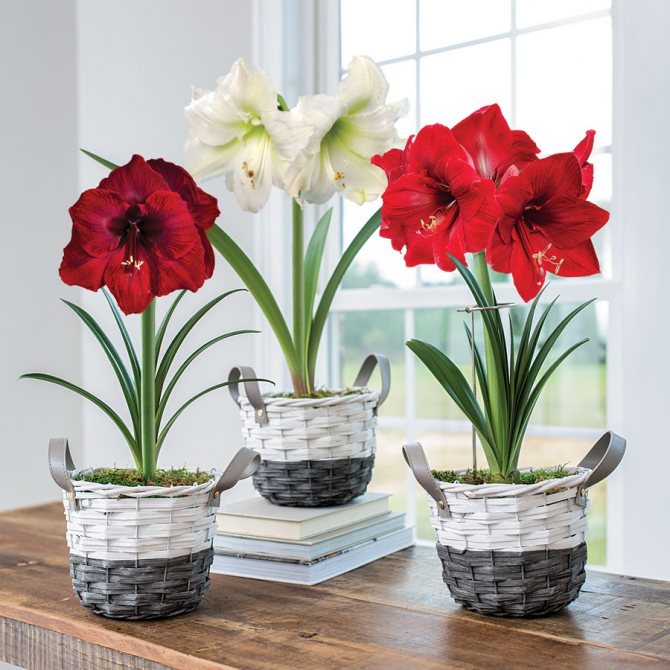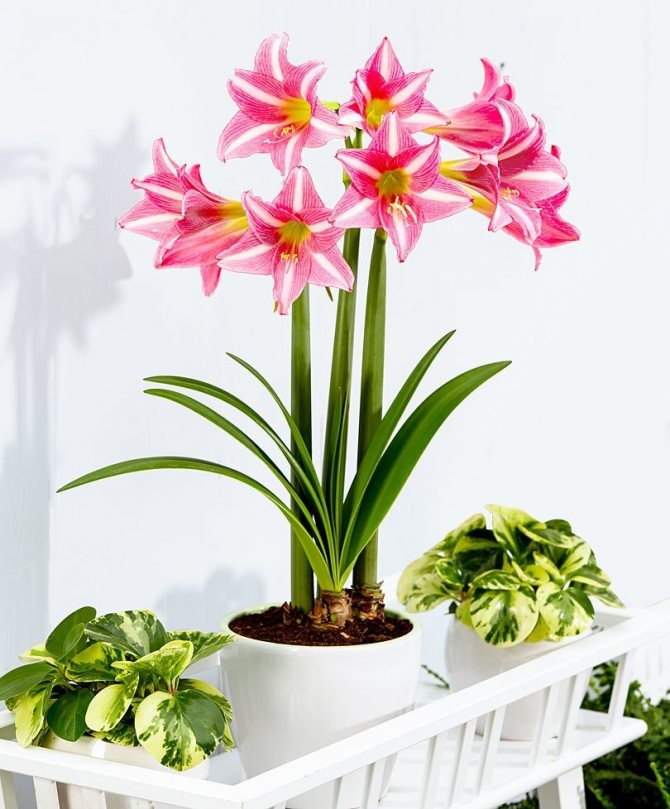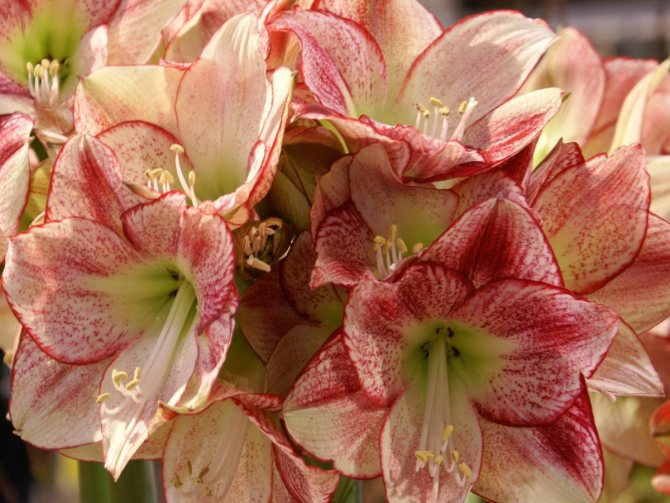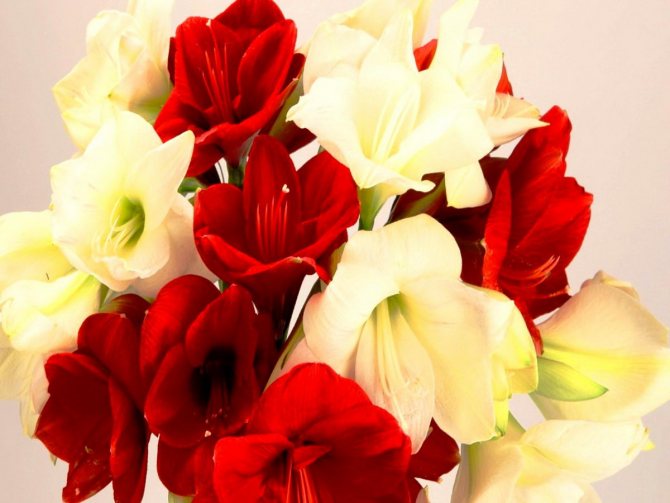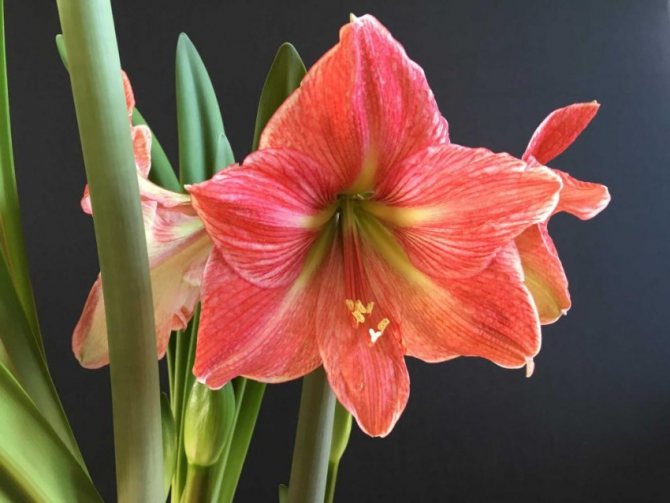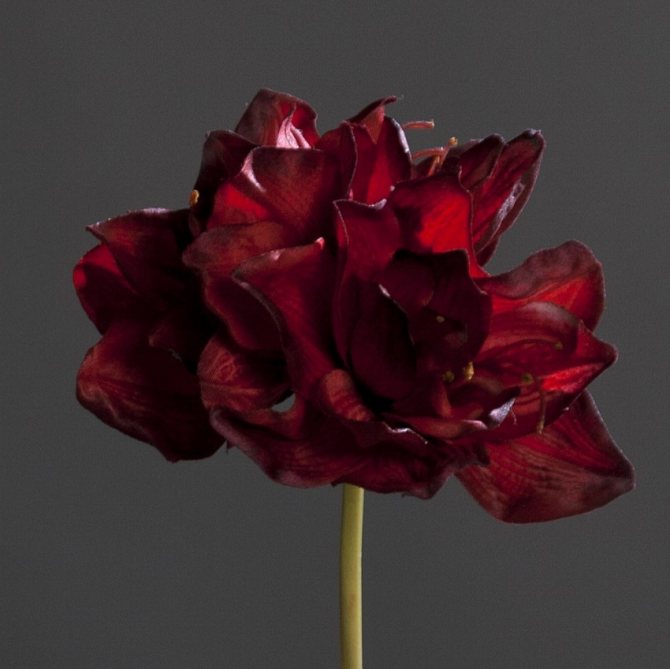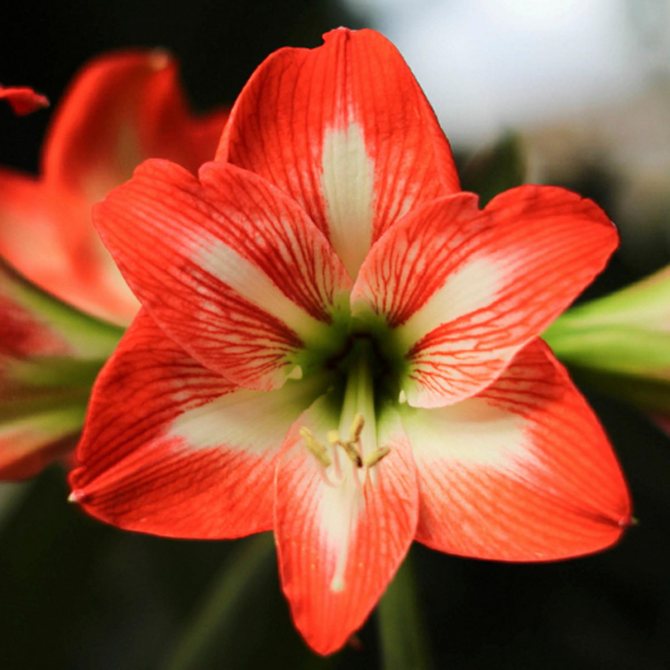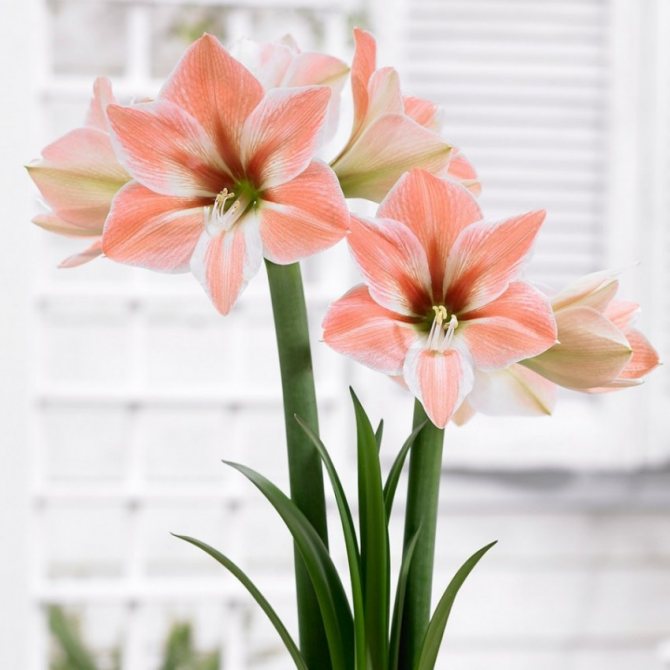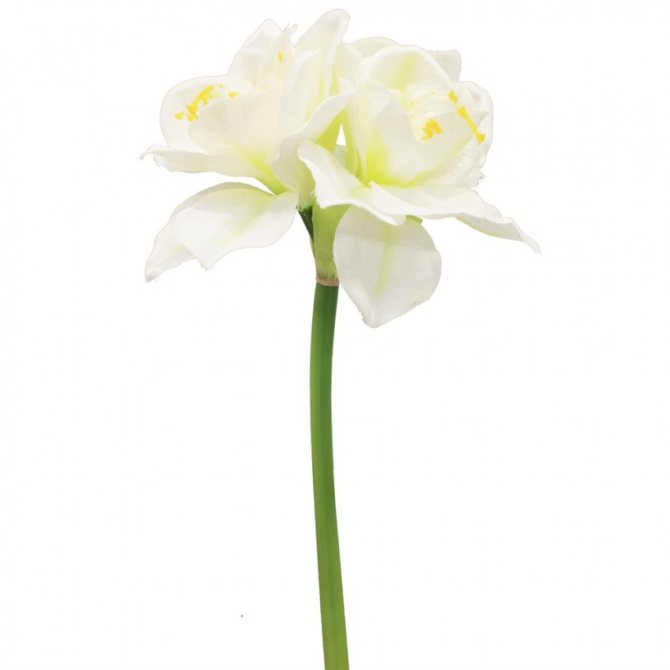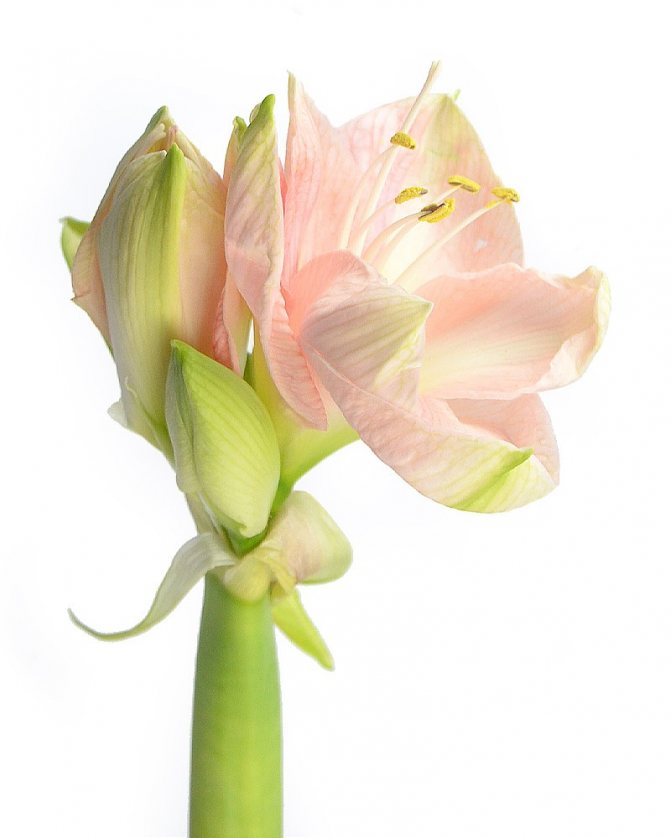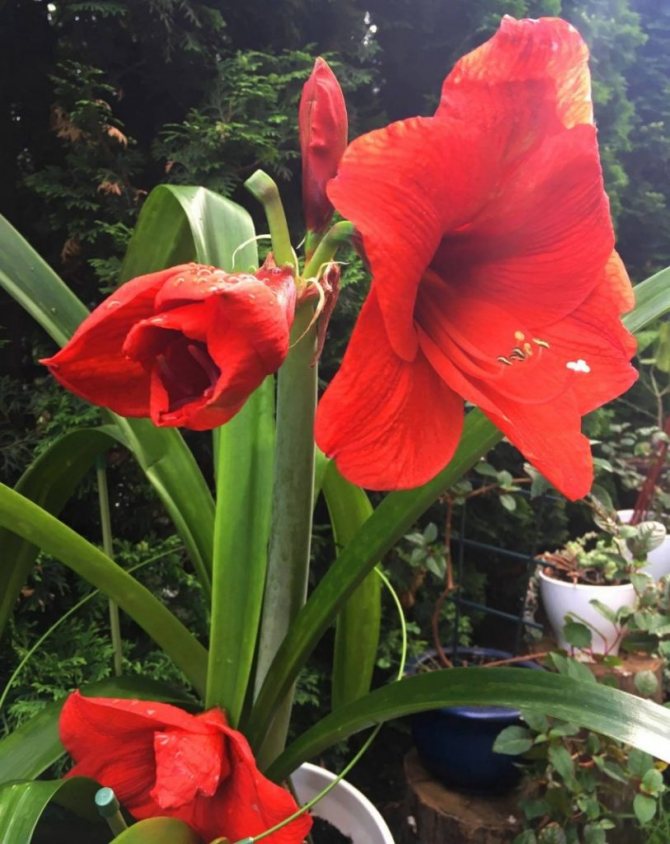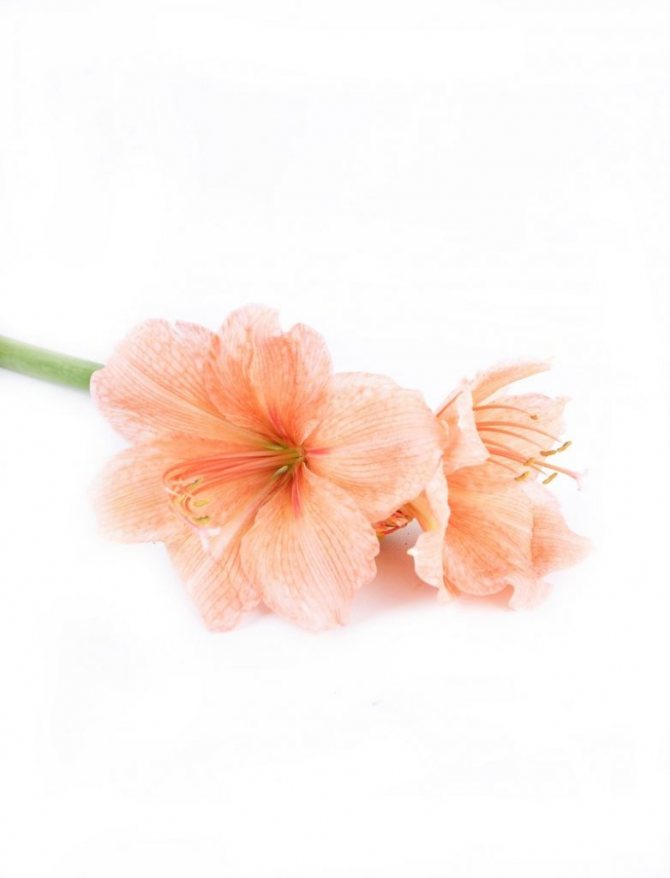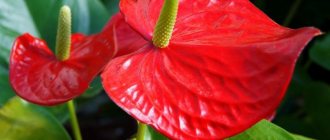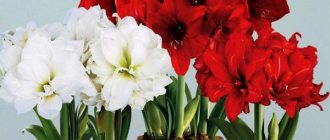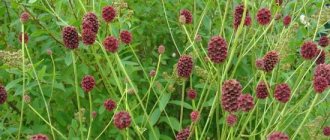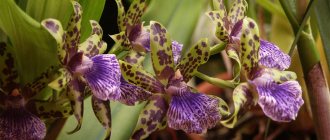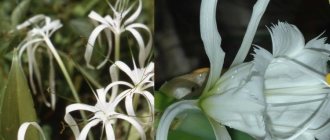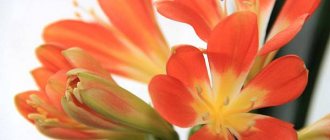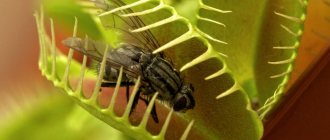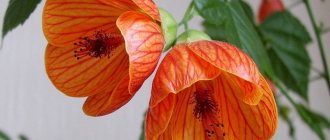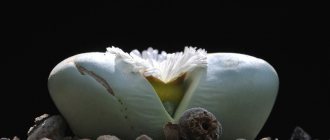Florists have recently begun to show interest in tropical plants more often, which add sophistication and originality to the home interior. Amaryllis belongs to such outstanding representatives of flora. Its large flowers of various colors will not leave anyone indifferent. And although the plant blooms for only a week, the contemplation of this exotic will give a lot of positive emotions.
Description
The amaryllis flower resembles a beautiful hyperstrum in its appearance, which often causes confusion. A large (up to 12 cm) fleshy bulb of a flower, in the shape of a pear, produces a strong bright green stem - a peduncle, the leaves of amaryllis are long - up to 60 cm, belt-like.
The most striking differences in the appearance of amaryllis from hyperstrum are as follows:
- Amaryllis leaves appear only after flowering; foliage is present on flowering hyperstrum;
- the peduncle of the hyperstrum is hollow inside the gray-green color, the stem of the amaryllis is dense, casts a burgundy color;
- The amaryllis bulb is pear-shaped, while the hipperastrum is round.
Attention! The amaryllis bulb is poisonous! Its juice contains the alkaloid lycorin, which can cause burns on the skin. Therefore, you need to work with the plant in rubber gloves.
At the end of the stem of the amaryllis, one or more large, fragrant lily-shaped flowers unfold. The shade of flowers can be white, red, pink, crimson, there are varieties with variegated flowers.
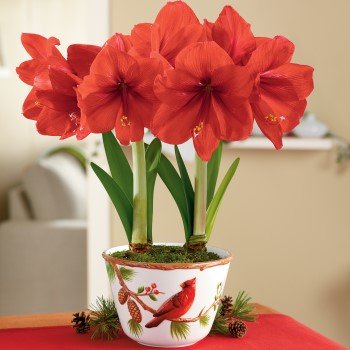
Appearance
Amaryllis varieties
For a long time it was believed that the amaryllis genus is represented by a single species - Amaryllis belladonna or beautiful. Modern botanists claim that some more plants belong to the genus, for example Amaryllis paradisicola. Almost all modern amaryllis varieties are derived from the amaryllis belladonna species.
Breeders have bred varieties of indoor flowers of amazing beauty: the diameter of the amaryllis flower reaches 13 - 15 cm, there are not only simple (for example, Exotic, Rosalie, Moonlight), but also double forms (Snow Queen, Pink Nymph).
Varieties with stripes on the petals of a flower or a zyon, painted in a different color, look spectacular. For example:
- Durban is a cultivar with a bright red flower, with a white throat;
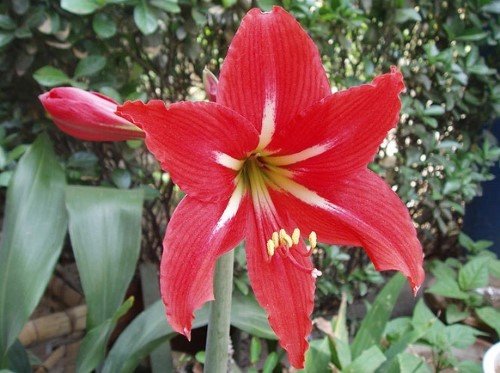

Durban - Pink gorgeous - the flowers of the plant are pink, with white longitudinal stripes;
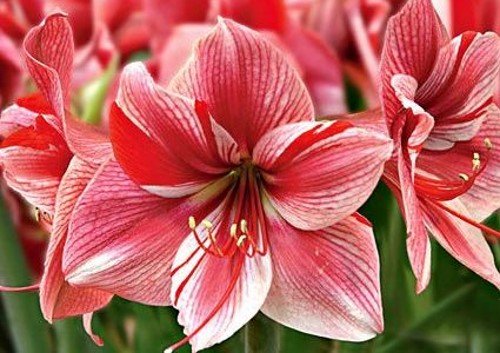

Pink - Parker is a dark pink flower with a yellow-colored neck.


Parker
All amaryllis varieties have a pleasant aroma. You can appreciate the lush beauty of the amaryllis by looking at the photo of the flower.
Views
Amaryllis is of two types.
Amaryllis Belladonna
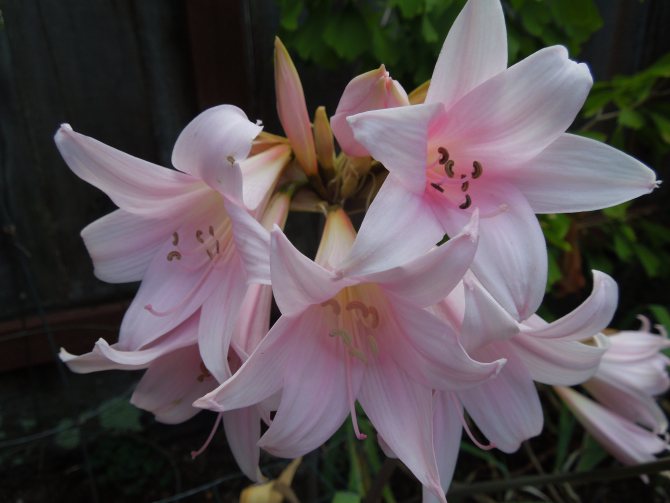

Amaryllis Belladonna
The most popular type grown by flower growers. The green stem of the plant reaches 50 cm. Leaves, 3 cm wide and 50 cm long, retain their green color all winter, they are arranged in pairs. Leaf plates appear in the fall, die off at the end of spring. The plant goes into a dormant state. In August-September, the bulb (its diameter is 5-10 cm) produces a bare peduncle, sometimes there can be two of them.
The umbrella-shaped inflorescence consists of 2-12 funnel-shaped flowers. Each individual flower has 6 petals, the size of the flower is from 6 to 10 cm. The color can be different - white, pink, red and even purple. Peduncles have a pleasant, delicate aroma.
Amaryllis Paradisicol (Amaryllis Sarniensis)
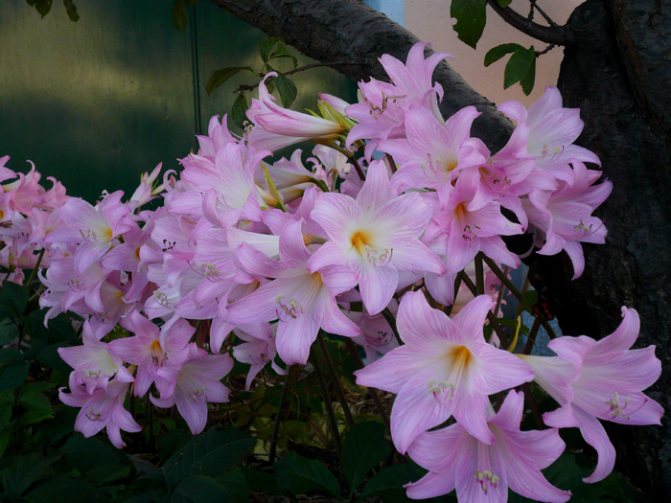

Amaryllis Paradisicol (Amaryllis Sarniensis)
This type of amaryllis naturally grows on stony dry areas in the mountains. Up to 21 flowers bloom on one leafless peduncle. Flowers are deep pink in color, have a strong aroma. Not grown as a room culture.
Features of agricultural technology amaryllis
This flower in the climate of our country is grown only indoors. The life cycle of amaryllis, like all bulbous plants, is divided into an active phase of growth and flowering and a dormant period. Care and environmental requirements are different during these phases.
During the active phase, amaryllis requires:
- Adequate, but not bright lighting, with 15 hours of daylight. Flowers are preferable to place on the southeastern windows. On windows facing south, the amaryllis will have to be shaded during the brightest hours of the sun so that the foliage does not burn.
- Regular watering with warm, settled water. You need to water the flowers through the pallet, without getting water on the bulb and leaves. The soil during the flowering period of amaryllis should always be slightly moist, but the water should not stand in the pan! It is very important to make sure that the flower pot does not stand in a cold draft. The combination of low temperature and moist soil is detrimental to the roots and bulbs of amaryllis.
- Comfortable temperature for actively growing amaryllis is +22 +24 degrees in the daytime, +20 degrees at night.
- During the dormant period, which lasts about 3 months, the amaryllis pot is removed to a dark and well-ventilated room, with a temperature of +12 degrees. Watering the plant stops, only the soil where the bulb sits is lightly sprayed. This is done every 10 days. Regular watering is resumed only when the amaryllis peduncle stretches up to 10 cm.
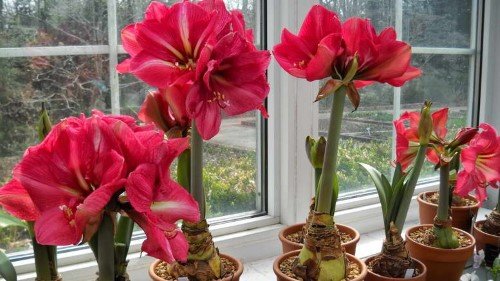

Possible problems
Taking proper care of the plant will ensure that it will bloom every year. The appearance of amaryllis will tell the grower about care errors:
- the leaves began to turn yellow, which means that watering is too frequent and excessive;
- leaf plates darken, and later rot - water does not seep through the drainage, it stagnates in the soil;
- the color of the foliage turns pale, the flowers droop - the air is too humid, excessive watering;
- perennial inflorescences turn pale - direct sunlight falls on the flowers. Shade the flower or rearrange it to another place where the light is diffused.
- amaryllis does not bloom - there is no rest period for the exotic or the planting container is too wide.
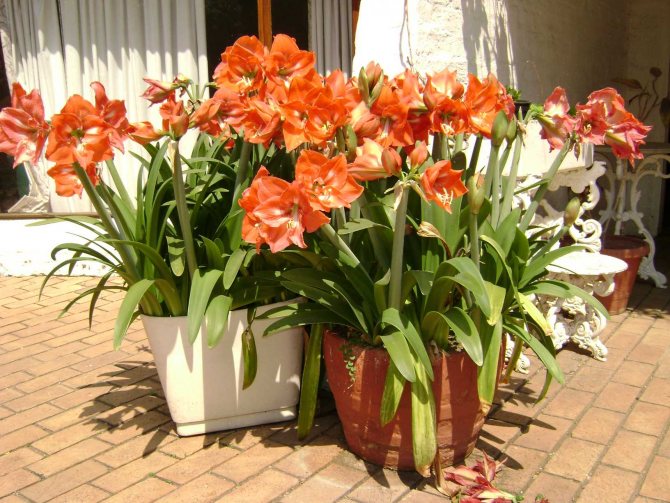

Preparing the pot and soil for amaryllis
A flower pot for a plant is chosen heavy and wide enough, giving preference to a ceramic one. Amaryllis throws out a peduncle up to half a meter long, on which it forms large flowers, so the plant requires a strong, stable base. The size of the pot is selected, focusing on the diameter of the bulb, from it to the walls of the container should remain no more than 5 cm.It is better not to save at the depth of the pot, the amaryllis has a developed root system that requires enough space.
When choosing a soil for amaryllis, you can choose a purchased substrate for bulbous plants. But, you can make a good mixture at home. Several proven soil compositions for amaryllis:
- sod land, river coarse calcined sand and humus, taken, in a ratio of 2: 2: 1;
- garden soil, humus, peat, sand in equal parts;
- garden soil and humus in equal proportions, and sand, twice as much in volume.
At the bottom of the flower containers, with the obligatory presence of drainage holes, a layer of expanded clay, gravel or pebbles, 2 cm thick, is poured. A layer of clean sand of the same thickness is poured on top of the drainage, and prepared soil is poured only on such a pillow.
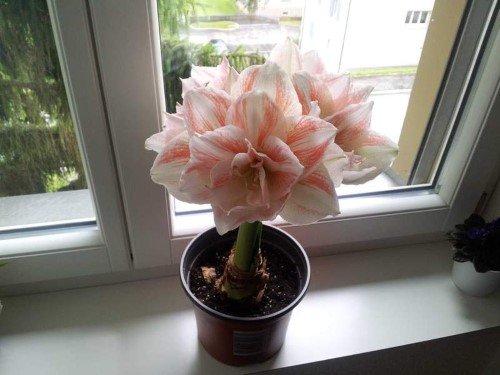

Amaryllis in a pot
Reproduction methods
When breeding amaryllis at home, you need to be patient. The perennial will release its first flowers only in the third year, if at the same time its "place of residence" has not changed.
There are several breeding methods.
Seeds
To obtain seeds, you need to collect pollen from the stamen of one inflorescence with a brush and transfer it to the stigma of another flower. It takes 30 days for the seeds to ripen. They are collected and immediately planted in a nutrient substrate, consisting of sod and leafy soil with the addition of humus.
The seeds are deepened into the soil by 0.5 cm, moistened. The temperature of the soil substrate should not drop below + 20 degrees. When the first three leaves appear, the seedlings are transplanted into separate containers.
Department of children
The simplest method is vegetative: separating the babies from the mother's bulb. From an adult bulb, small children with roots grow. They are planted in a separate small container for rooting. The grown bulbs are transplanted into larger pots. Young amaryllis blooms in the third year. A rest period is not required until the first flowering.
Dividing the onion
Cut the top of the onion with leaves, without digging it out. Make 4 vertical cuts down to the soil, dividing the bulb into equal parts. Sprinkle the sections with ash or coal powder. Insert wooden sticks between them. For germination, it is necessary to create certain conditions: diffused light, air temperature + 25 degrees, watering. When the first leaf appears, the young plant is planted in a separate pot.
Planting amaryllis
In order for the plant to please with lush flowering, it does not cause any trouble, you need to choose only healthy bulbs for planting. They should be large, full-bodied, rather tough, without dents, wounds and traces of mold. Onions with good fleshy whitish roots should be preferred.
Before planting, amaryllis bulbs are cleaned of dry brown scales, leaving only fresh light tissue. Planting material for the prevention of fungal diseases is etched for half an hour in a raspberry solution of potassium permanganate or any fungicide (Maxim, Fitosporin). After processing, amaryllis is dried for about a day.
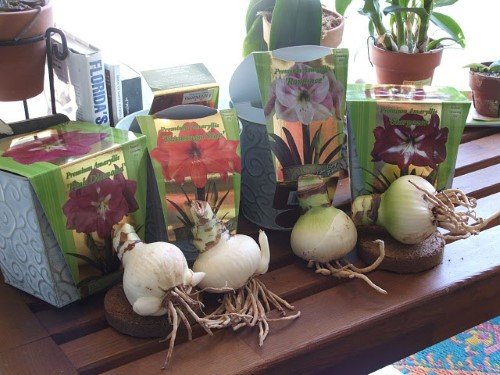

Bulbs
Prepared soil is poured into a flower pot to half the height of the dishes. 1 - 2 sticks of long-playing mineral fertilizer are stuck in the middle of the pot. The bulb is lightly pressed into the soil, with the blunt end down, strictly in the center of the pot. Cover with soil, leaving at least a third of the bulb on the surface. Immediately after planting, amaryllis is watered directly over the bulb, allowing the soil to settle well. If necessary, fill up the earth.
Immediately after planting the bulb in the ground, the active growth of the plant begins. Flowering occurs in 8 weeks from the moment of planting.
Temperature regime
In order for the plant to grow and develop normally, it is necessary to maintain a certain temperature in the room. The value of this indicator depends on what phase of development the flower is in.
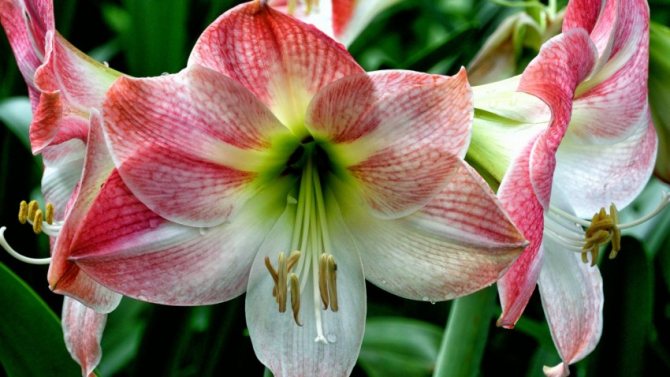

If amaryllis has a phase of active growth, then the temperature should be at the level of 18 - 25 ° C. For a dormant period, it is better not to allow it to exceed 16 ° C and fall below 10 ° C.
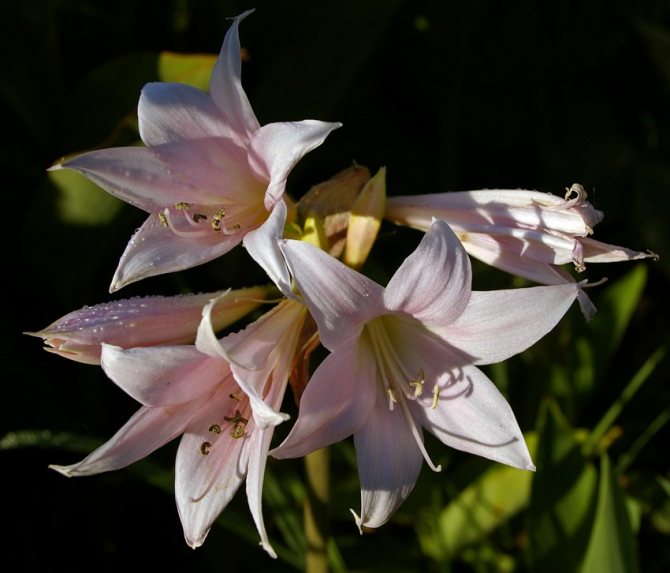

Try to avoid sudden temperature fluctuations. They can adversely affect the health of the flower.
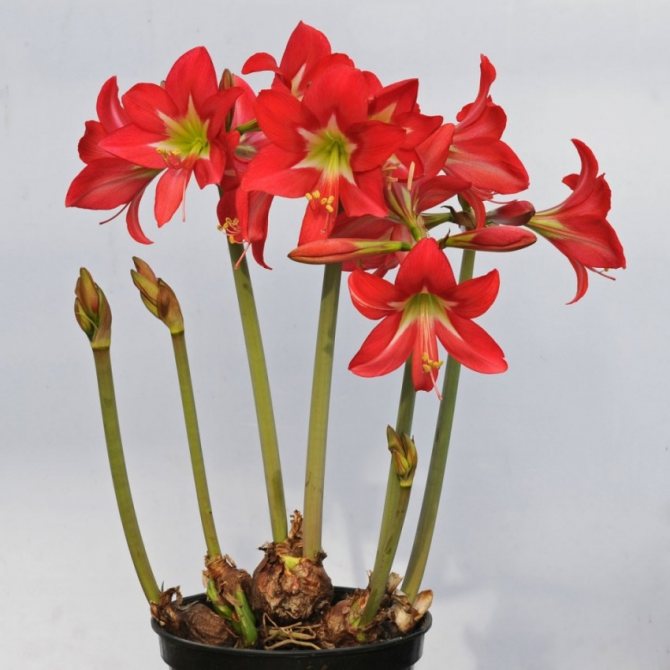

Blooming amaryllis care
In addition to regular watering (every 3-4 days), a flowering plant needs additional feeding. Starting from the period of bud formation, amaryllis is watered with a fertilizer solution every two weeks. Any phosphate-potassium fertilizers for flowers are suitable (Kemira lux, Raduga, Agricola, Ava). Fertilizers are diluted in water, according to the attached instructions.
Top dressing is stopped when the amaryllis fades and its aerial part dies off. If the amaryllis bulb throws out more than two peduncles, it is recommended to cut off the extra stems so as not to weaken the plant.
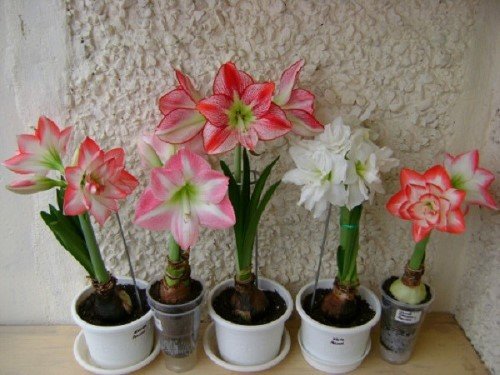

Mr. Dachnik recommends: amaryllis is a flower that makes wishes come true
According to feng shui, amaryllis is a bright representative of the fire element. This energy is especially evident in plants with red flowers. The best place for him is the kitchen. The divine flower symbolizes pride, inaccessibility, masculinity.
The magical properties of the plant are manifested in the ability to fulfill desires.
Convenient location, caring care will make your dreams of love, travel, and self-improvement come true. Amaryllis brings peace, well-being and comfort to the house.
Pests, diseases
The plant can be subject to diseases such as rot, mold, burns. Prevention and treatment consists in removing the affected leaves or parts of the bulbs, and treating the plant with fungicides (Bordeaux mixture, foundationol).
Of the pests, the flower can be annoyed by aphids, scale insects, spider and onion mites, thrips, mealybugs. When buying a plant from a store, you need to make sure it is free of pests. It is best to quarantine the amaryllis for a couple of weeks after purchase, away from indoor plants. If it was not possible to avoid pest infestation, the plant is treated with appropriate insecticides (Fitoverm, Aktara, Kleschevit). Washing the plant with soapy water helps against aphids and scale insects.
Location and illumination
This flower is quite light-requiring. However, the lighting should not be direct, but diffuse. The best place for a pot is southeast or southwest facing windows.
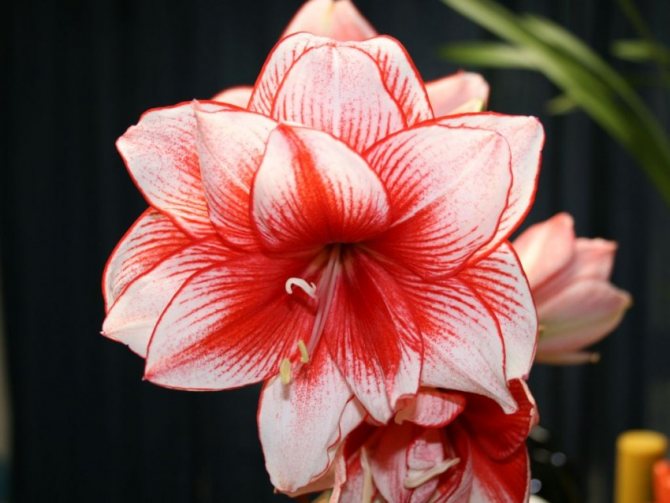

Necessarily the device of the shading system. It can be made from a piece of gauze or curtains. In summer, the daylight hours of the plant must last at least 16 hours.
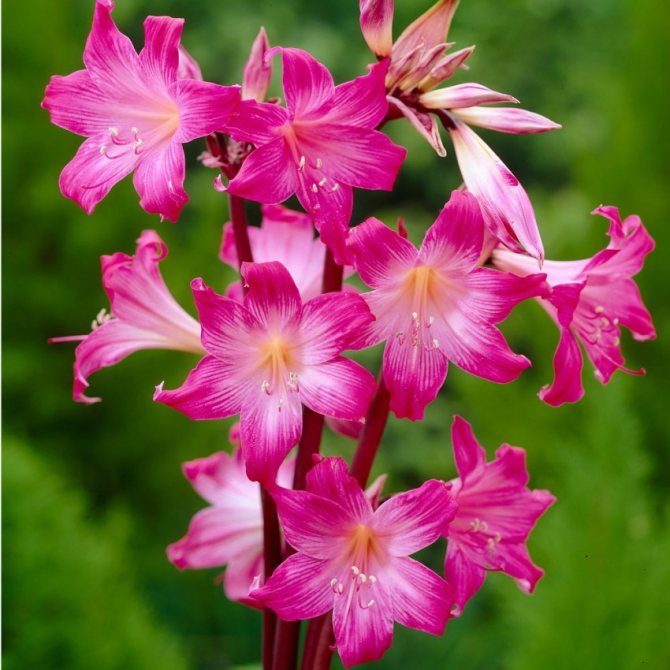

Transfer
The flower does not require an annual transplant into a new container; it is enough to replace the topsoil with a fresh substrate every year.
Once every 3-4 years, amaryllis needs to be transplanted into a new container, in parallel separating the baby from the bulb. In order for the plant to tolerate the transplant well, 3 days before the operation, it is watered abundantly. The flower is carefully taken out of the pot and the earth is shaken off from the roots. The bulb and roots are examined in the most careful way.
All dried, rotten parts are cut off, the cuts are treated with brilliant green or powdered with charcoal.
How is amaryllis different from hippeastrum?
Amaryllis is often confused with hippeastrum. There is indeed a similarity between them: long lanceolate leaves, a flowering stem, large flowers.
What is the difference between them?
- The main difference is in the peduncle. The stem of amaryllis is hollow, purple in color, its length (in some varieties) reaches 90 cm. The stem of the hippeastrum is much smaller, not hollow inside, its color is green, purple-gray and even brown.
- Flowers differ in size and aroma. Flowers in hippeastrum are larger (up to 22 cm in diameter) than in amaryllis (from 9 to 13 cm). The number in the inflorescence is also different: in the hippeastrum - from 2 to 4 flowers, and in the amaryllis - from 6 to 12. The amaryllis flower is funnel-shaped, in the hippeastrum it is orchid-like. Amaryllis flowers have a significant aroma, hippeastrum has a weak aroma, in some varieties it is completely absent.
- During the year, amaryllis blooms once, hippeastrum - twice.
- The shape of the bulbs is different. Amaryllis has a pear-shaped, covered with scales, which are pubescent from the inside, its maximum size is 12 cm.The bulb of the hippeastrum is rounded, like onions, its size does not exceed 9 cm.
Blooming amaryllis will create a festive atmosphere in any room. It looks great in a bouquet; various flower arrangements are made with it. Caring for an exotic plant is not difficult, even a beginner grower can do it.
Useful Tips
Quite often, inexperienced growers are faced with the problem of the lack of flowering in amaryllis, although it seemed that all the conditions for the plant were created. The most common reasons for the refusal of amaryllis to bloom:
- a large volume of the pot, the bulb spends all its resources on the production of babies, there is simply no energy left for the flowering;
- lack of nutrition during the current growing season will only affect the next flowering (or rather, the absence thereof);
- the amaryllis bulb is planted too deeply in the ground;
- lack of lighting, in winter amaryllis will have to be supplemented with special lamps;
- the plant has not passed the dormant period it needs;
- insufficient size and age of the bulb, the baby begins to bloom at 4 years old.
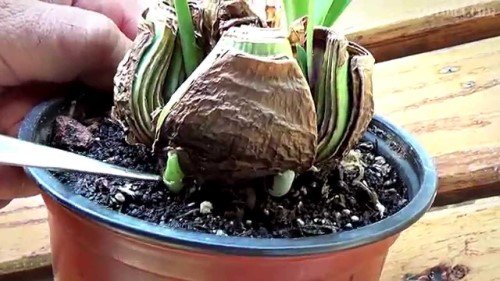

Reproduction by division
The easiest way to propagate amaryllis
For a beginner grower, the easiest way is to plant amaryllis with a baby (small bulbs growing near the bottom of an adult bulb). With the next transplant of amaryllis, the baby is carefully separated from the mother plant. The onions are cleaned and processed in a pink solution of potassium permanganate, and planted in a suitable container for growing. It is important to remember that the bulb grows, therefore, it needs to choose a pot "for growth".
The child does not need to organize a rest period. Before the first flowering, the baby amaryllis is watered and fed as usual.
Watch also a video on the topic:
Popular varieties
Breeders have put a lot of effort into developing unusual amaryllis varieties. The work in the field of breeding is carried out in three directions:
- growing large flowers;
- obtaining flowers with interesting colors;
- breeding varieties with a flower shape different from the parent.
Amaryllis Red Lion
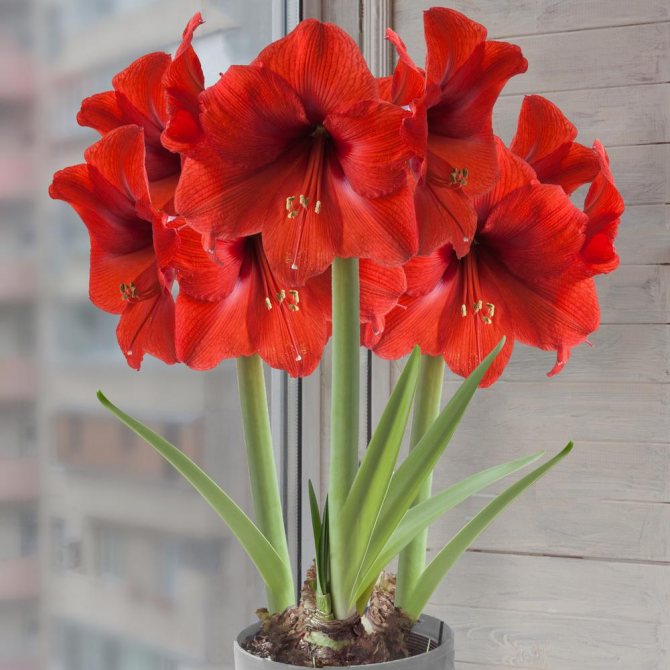

Amaryllis Red Lion
This variety has a second name - "red lion". Bright red large inflorescence blooms on a green peduncle. On one flower arrow, the height of which is 50 cm, 3 or 4 flowers bloom. This is one of the favorite varieties of flower growers. The plant creates a festive atmosphere in the room when it is still winter outside. The magnificent flowers are eye-catching, their color is similar to the winter sun setting over the horizon.
Amaryllis Aphrodite
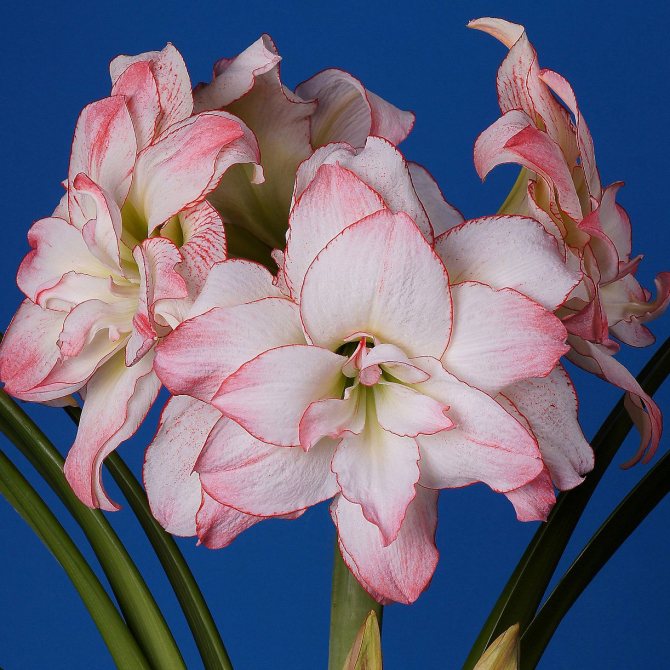

Amaryllis Aphrodite
Bulbous perennial has linear leaf plates, the length of which is about 70 cm. The peduncle grows to a height of 70-80 centimeters. The diameter of the flower can reach 25 cm. White double flowers have a pink border around the edges.
Amaryllis Elvas
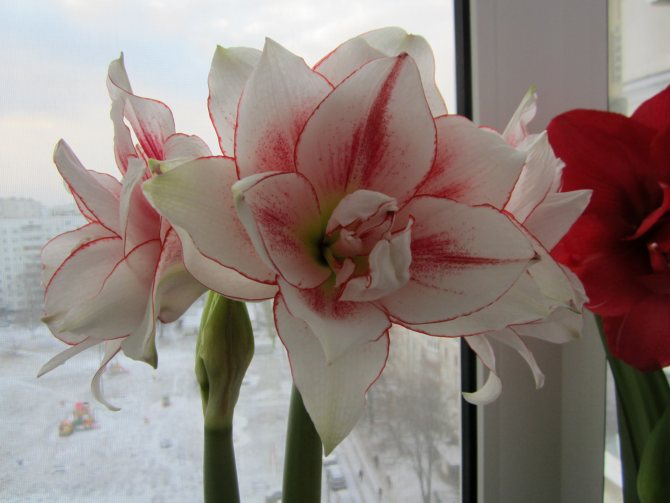

Amaryllis Elvas
A perennial 50 cm high with a narrow stem attracts attention with an unusual flower color. A double large flower (diameter 15-25 cm) of a snow-white color has pink-crimson blotches in the center. The oval-shaped petals are pointed, along their edges a bright crimson edging appears.
Amaryllis Ferrari
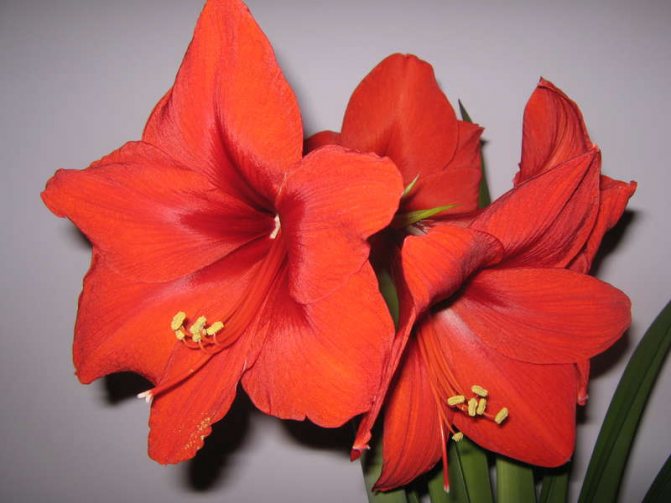

Amaryllis Ferrari
One of the most beautiful amaryllis varieties. The height of the perennial is from 50 to 70 cm. Large red flowers with satin petals bloom on the flower arrow. It can bloom in any season, it all depends on the planting date. The plant is grown not only indoors, but also outdoors in regions with warm climatic conditions in winter.
Amaryllis Gervase
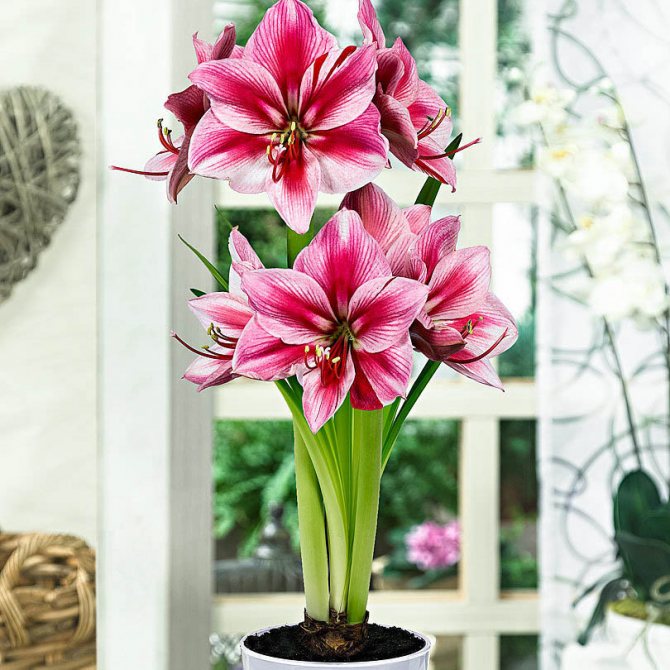

Amaryllis Gervase
The main difference from other amaryllis is the unique color of the flowers. On one arrow, the height of which is about 70 cm, there are no flowers that are exactly the same in color. On the white background of the petal, pink-cherry stripes and reddish strokes diverge, their size is different, the location is arbitrary. There are flowers with fully colored red petals.
Amaryllis Minerva
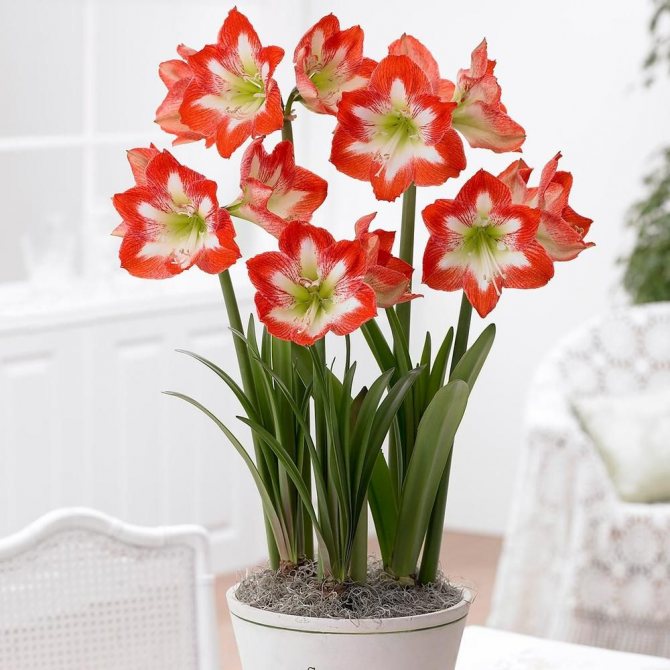

Amaryllis Minerva
Large red flowers bloom on a sixty-centimeter peduncle. A white strip runs along the center of the petals, from which thin rays of the same color extend. The flower seems to glow from within. The greenish core of the flower makes the flower even more expressive.
Amaryllis Exotica
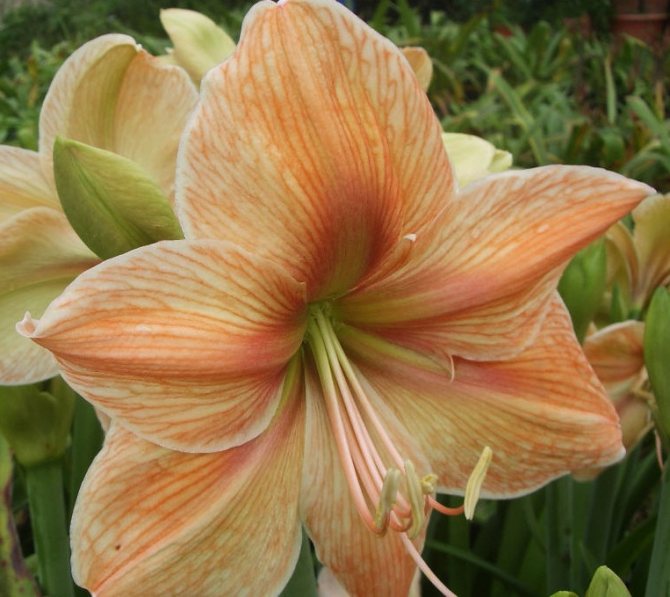

Amaryllis Exotica
The new bulbous hybrid has an extraordinary flower coloration. On a thickened arrow with a length of 40 cm, large flowers, similar to asterisks, bloom. The size of the flower will surprise even sophisticated flower growers: the diameter reaches 20-22 cm. The color is tricolor: the petals are white or peach, orange in the center, the middle part of the flower is greenish. Wide petals have an oblong-oval shape, pointed towards the tips. In the inflorescence 3-4 flowers are collected, which have a delicate aroma. Flowering occurs in the winter months.
The belt-like leaves are deep green in color.The bulb is large (diameter 10 cm), round, can produce 2-3 peduncles.
Amaryllis Durban
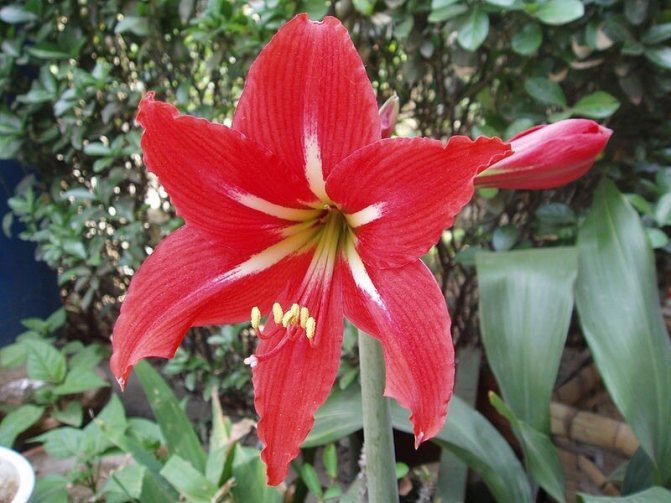

Amaryllis Durban
Amaryllis of this variety has large bell-shaped flowers. The color of the petals is deep red at the edges with a white radiant center.
Amaryllis Parker
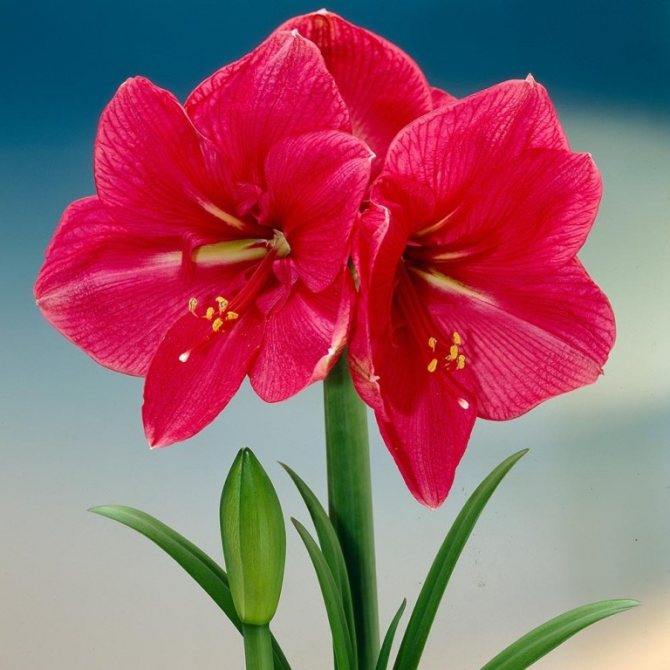

Amaryllis Parker
Flowers of the "Parker" variety are purple-pink with a yellow, radiant center.
Amaryllis Vera
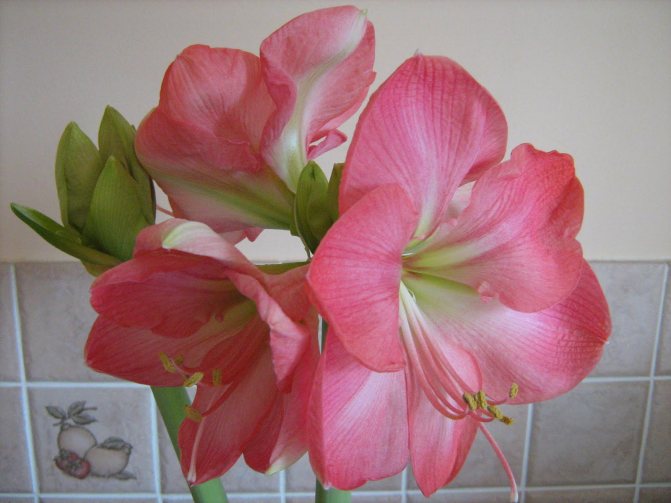

Amaryllis Vera
Flowers of a pale pink shade have a pearlescent tint, giving the amaryllis a special sophistication and sophistication.
Amaryllis Macarena
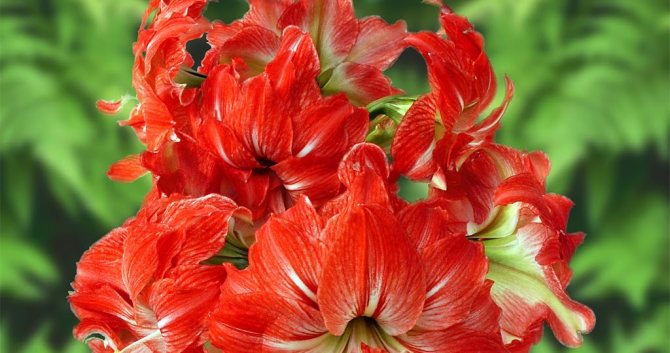

Amaryllis Macarena
The bright red petals of a double flower with white stripes give the flower a unique charm.
Amaryllis Nymph
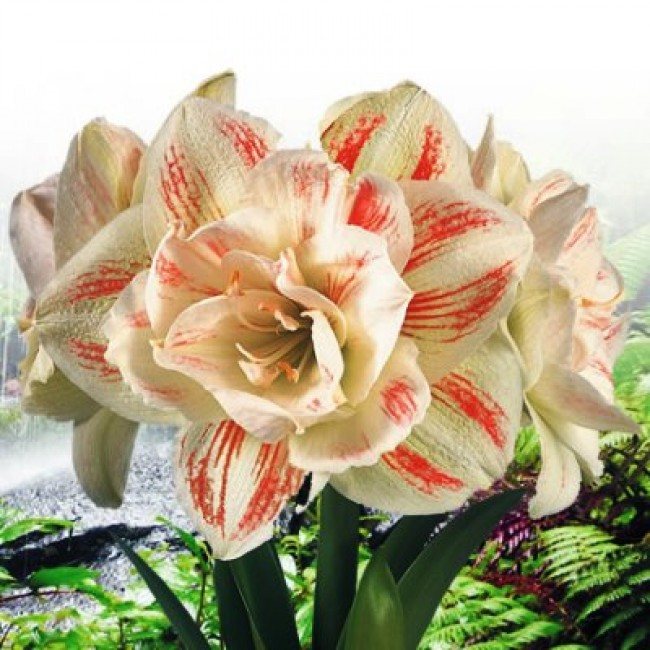

Amaryllis Nymph
Perennial with lush, double inflorescences similar in shape to peonies. The length of the peduncle is about 45 cm. One bulb can release up to three arrows, each of which blooms 3-4 flowers with a diameter of 22 to 25 cm. The flower looks like a lush ball due to the large number of petals: there are 12 to 14. On cream the background of the petals clearly shows through red strokes and stripes.
Amaryllis Grandeur
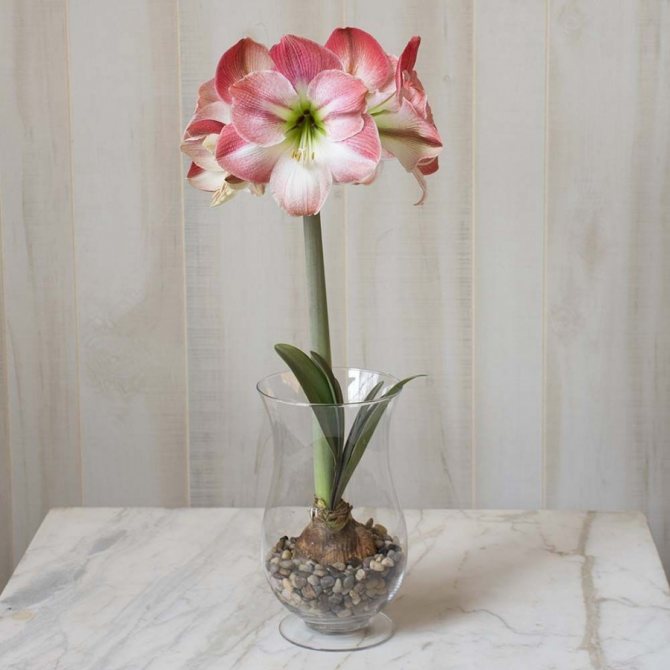

Amaryllis Grandeur
The main difference from other varietal species of amaryllis is narrow petals with a variegated color. The pale pink shade of the petals turns into a deep pink. The pharynx of the flower is yellow-green in color.
Care errors and their elimination
Problems in growing Amaryllis and methods for their elimination:
| Problem | The reasons | Decision |
| Pale flowers, light leaves | Too much light | Remove the flowerpot from direct sun, provide diffused light |
| Darkening of flowers | Cold air, excessive dampness | Do not lower the room temperature below +18 degrees during the growing season, water moderately |
| Yellowing of leaves during the growing season | Excess moisture | Reduce the number of waterings |
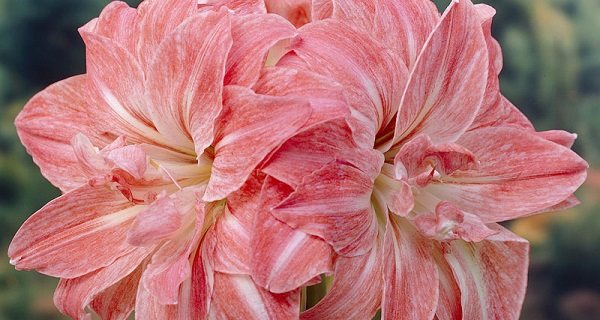

Features of seasonal care
Caring for Amaryllis during flowering and rest:
| Conditions | Dormant period | Growing season |
| Lighting | Not required | Bright, diffused light |
| Watering | Absent | Moderate |
| Temperature | About + 10-15 ° С | + 22-24 ° С |
| Fertilizers | Do not contribute | 2 times a month |
Blooming amaryllis at home
Wild amaryllis enters the flowering phase in early autumn. In indoor floriculture, there are tricks on how to change this period. The easiest is to plant the bulbs at a different time. So, when choosing healthy specimens, they begin to grow immediately after planting, giving mature flower stalks as early as 7-8 weeks. Here you need to observe - if there are more than two peduncles, they are removed so as not to abundantly load the bulb with flowering.
When the first flower appeared and blossomed, some cut the peduncle and put it in a vase. Provided that the water is renewed every day, it can stay there for up to three weeks. You can not cut the peduncle, but it will stand the same, and will drain the bulb much more. To maximize flowering time, place the vase or flowerpot in a colder, darker place.
Watering
Change the intensity to rest and spring forcing. In order for a naked woman to flourish, it is necessary to monitor the moisture of the earth. As soon as it is dry, watered. After hibernation, they resume gradually when the sprout stretches 10 cm.
This is necessary so as not to provoke early foliage growth.
When rest comes, cut back. When the earthen coma dries out, it is carried out after 2 days, the interval is gradually increased, and brought to once every 50 days.
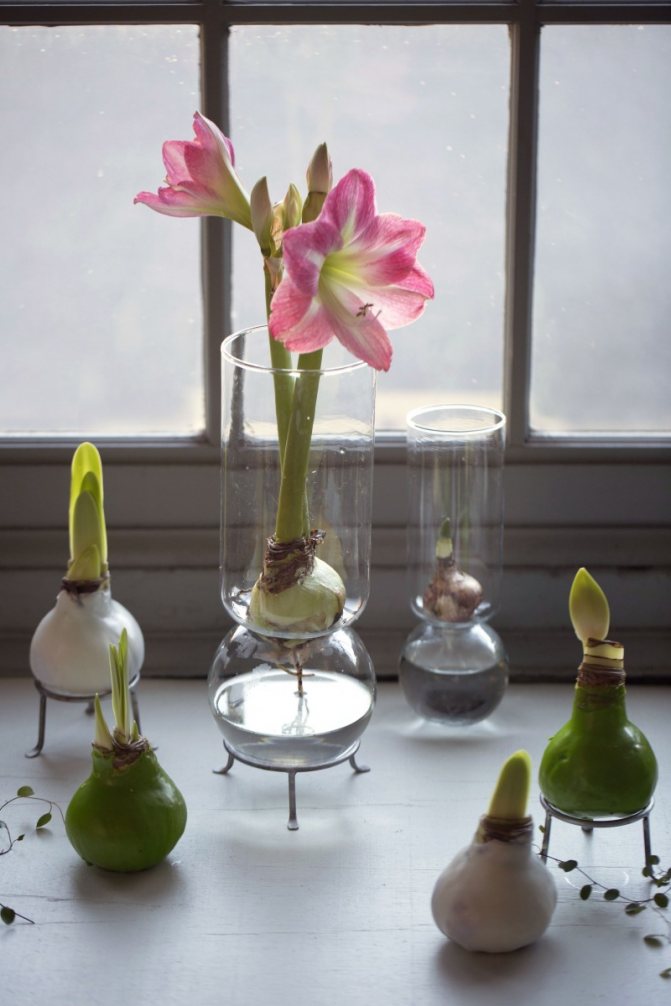

Answers to popular questions
Below you will find answers to the most popular questions that beginner growers ask when growing amaryllis.
Why is it growing poorly?
The main reasons why this flower can grow poorly can be as follows:
- the underground part of the plant is too depleted, since there are not enough nutrients in the soil;
- attack of "harmful" bugs, because of the fight against which there is no strength to grow and bloom;
- not enough light;
- waterlogged or too dry soil;
- the apartment is too cold;
- the plant did not have a dormant period;
- the bulb is too deep in the ground.
Why doesn't it give new shoots?
In this flower, new shoots are formed annually, if they do not appear after the plants have been transferred to a warm place for distillation, then:
- insufficient moisture in the soil;
- the bulb is damaged by rot or severely emaciated;
- too many babies, the growth of which takes the strength of the mother's bulb.
How often does it bloom?
Most Amaryllis varieties only flower once a season. But it happens that some specimens can bloom again. The main thing is that the flowering ends before the onset of the dormant season.
Nerina
Unusually graceful autumn flowering plants.
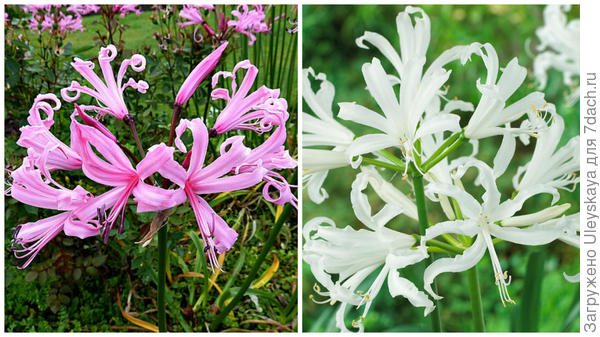

Her white-flowered form is Alba. Photo from the site jparkers.co.uk
Nerine bowdenii is native to South Africa, but its winter minimum is -15 ° C. Height - 45 cm, width - 8 cm. Pink flowers, diameter 8 cm. Decorative form f. alba (white flowers).
Nerina convoluted (N. flexuosa) - "compatriot" of the previous species with the same parameters and white-flowered form.
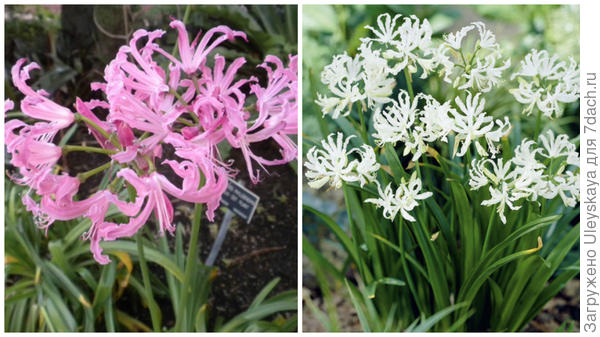

Photo from the site. Her white-flowered form is Alba.
Nerins are very interesting for ChPKK and South Coast, in other regions they can be grown in containers. They cannot stand waterlogging: the bulbs rot.
Zephyranthes
This name hides several types of bulbous plants with different colors of flowers. Lovers of indoor floriculture know them as "upstarts", but in the open field they are real rarities that bloom in late summer - early autumn.
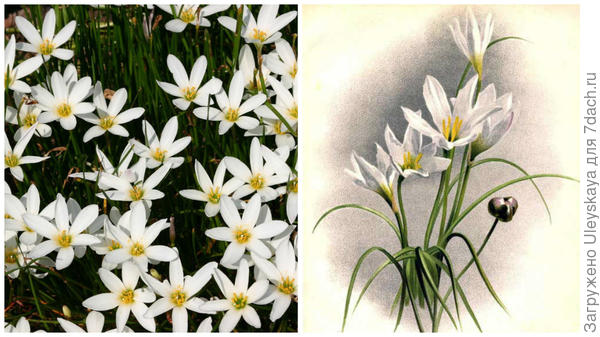

Zephyranthes white. Photo from the site. His drawing. Photo from the site
Zephyranthes white (Zephyranthes candida) originally from Argentina, Uruguay; height - 10-20 cm, width - 8 cm. Withstands -5 ° С, therefore, in the southern regions it can not be covered, but in the rest it can be grown in containers or well covered with humus, dry leaves.
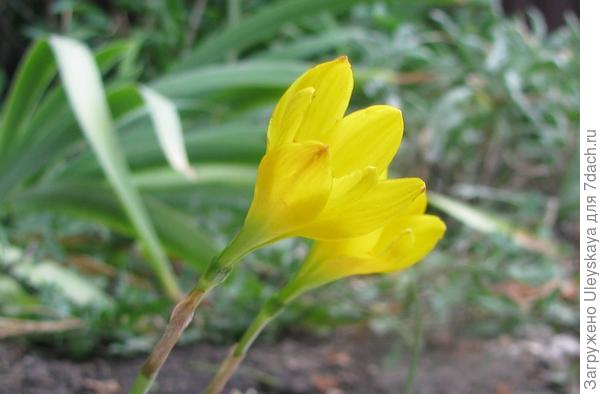

Zephyranthes lemon, photo by Svetlana (Samdolis)
Z. large-flowered (Z. grandiflora, syn. Z. carinata) is native to Central America.
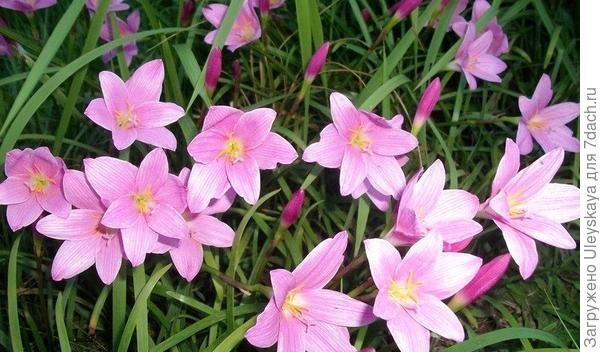

Zephyranthes large-flowered. Photo of the site from davesgarden
Height - 20-30 cm, width -5 cm. The flowers are pink, 7 cm long. It is thermophilic, so it is better to grow in containers.
Hypeastrum hybrid
It can be grown (with shelter) in the open ground of the ChPKK and on the southern coast of Crimea (hereinafter - the South Coast).
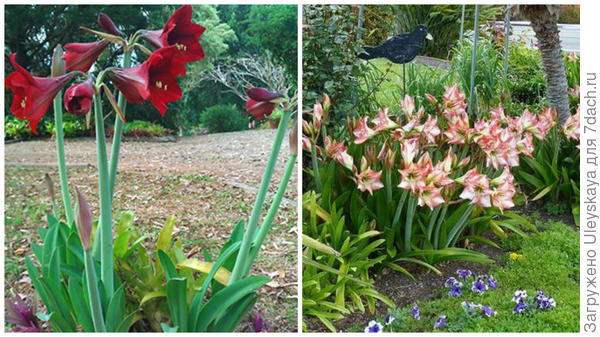

Hippeastrum hybridum (Hippeastrum x hybridum) is dozens of varieties with a height of 30-50 cm and a width of up to 30 cm. A large bulb forms a nest of daughter ones, separating and growing which, they get excellent planting material.
More winter-hardy (winter minimum 0 ° C), H. x acramannii.


Hippeastrum akraman. Photo from the site s215.
Hippeastrum are undemanding to soils; open sunny places are chosen for planting.
Gabrantus powerful
This is a relative of zephyranthes, from which it differs in flowers located at an angle to the peduncle.
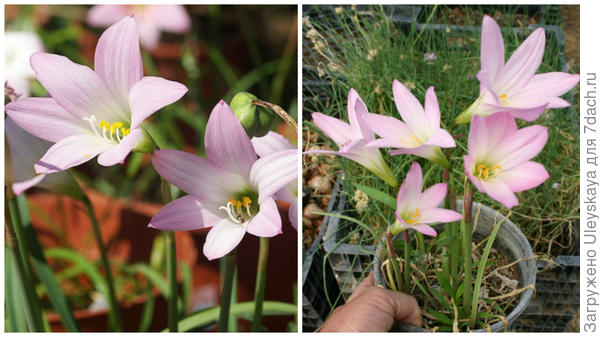

Gabrantus is powerful, general appearance. Photo from the site. Bloom. Photo from the site
Powerful Gabrantus (Habranthus robustus, syn. Zephyranthes robusta) is native to Brazil. Height - 20-30 cm, width - 5 cm. Winter minimum - 0 ° С. Best grown in containers.
Pankratium, or Illyrian pancratium
It is still a rare "lily-star" or "lily-spider".
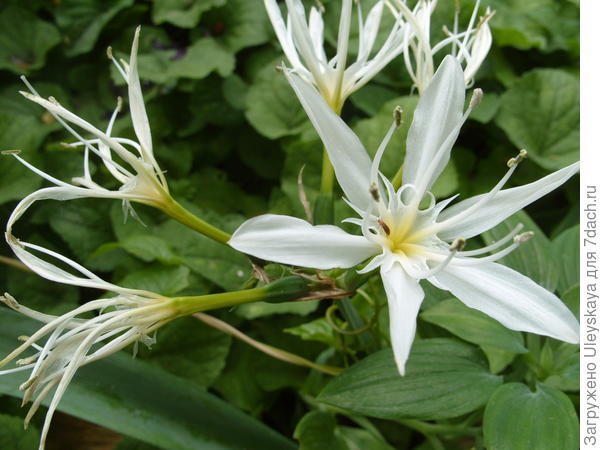

Pankratium Illyrian, photo by the author
Pancratium illyricum (Pancratium illyricum) originally from Corsica, Sardinia. Height - 40 cm, width - 15 cm; white flowers up to 8 cm in diameter, fragrant, bloom in late spring - early summer; when blooming, they are removed. The winter minimum is 0 ° C, so it can be recommended for ChPKK and South Coast of Crimea with fertile loose soils and shelter. Responsive to feeding and watering. Propagated by daughter bulbs.
Iksiolirion Tatar
A charming cold handsome man!
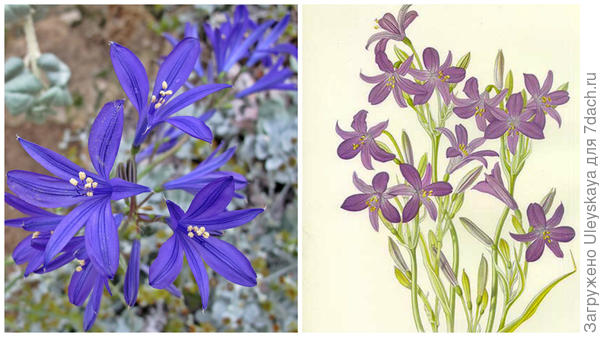

Iksiolirion Tatar. Photo from the site en.wikipedia.org. Drawing of a plant. Photo from the site ru.wikipedia.org
Ixiolirion Tatar (Ixiolirion tataricum, syn. I. montanum, I. pallasii) comes from Central and South-West Asia. Height - 24-40 cm, width - 5 cm. Bright blue flowers bloom in late spring - early summer.In central Russia, it requires shelter (-15 ° C - overwintering ceiling). Propagated by daughter corms in the fall.
Red burn is the most common amaryllis disease
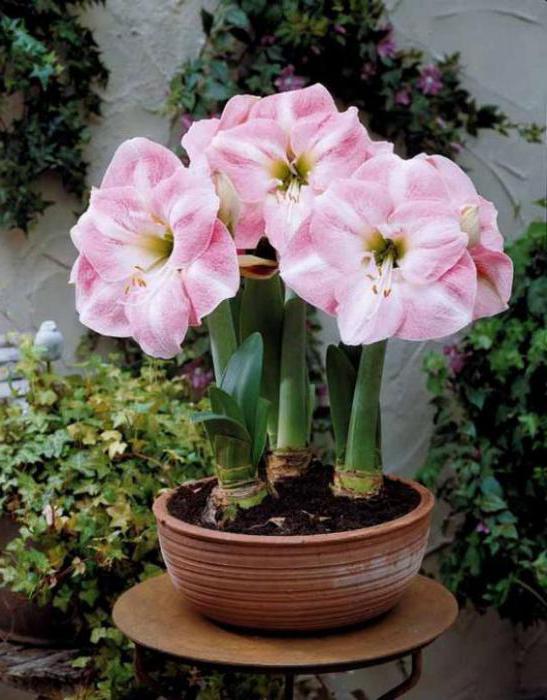

The already mentioned red burn is a disease that can affect both the appearance and health of plants. But this infection is not fatal. Red spots or blotches that develop into elongated ulcers with a red border can appear on the peduncles, the bulb itself, and on new leaves. The disease is often difficult to diagnose as superficial small red or pink spots may be missing on the outside of the plant. Due to infection, the leaves can change shape, and the peduncles can break easily, which makes the plants not very attractive in appearance.
Combination with other plants
The shape of the flower amaryllis is consonant with the lily. And planting these flowers next to me will look harmonious. Also, there will be no disharmony when daffodils, gladioli are located in the neighborhood due to their leaf shape similar to amaryllis.


The combination of amaryllis with undersized flowers
Amaryllis is beautifully combined with bright undersized flowers. Among them are muscari, garden begonia, primrose.
How to reanimate?
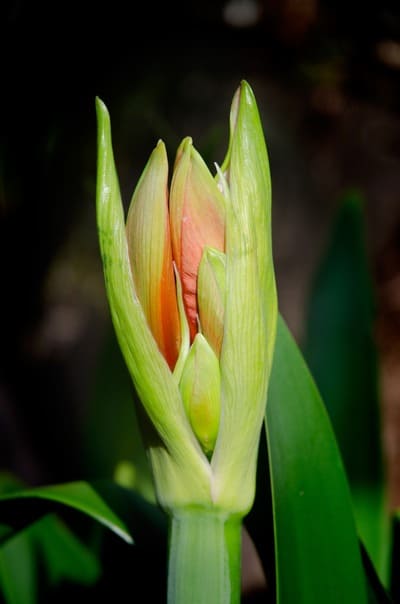

Even if symptoms of bulb rot appear, you can try to reanimate.
To do this, they remove all damaged areas, and the sections are treated with any antiseptic.
Then it is dried and processed in "Maxim".
After that, the affected bulbs are removed in a dark place for a couple of days.
Before planting, you need to inspect the bulb again and remove all dried parts.
In most cases, the bulbs subsequently “recover” and grow normally.
Hymenokallis smart
Exotic bulbous plant.
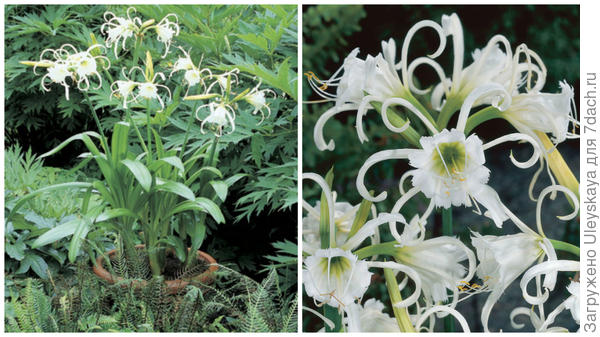

Hymenokallis is elegant, general appearance. Photo from the site. Flowers. Photo from the site
Hymenokallis elegant (Hymenocallis x festalis) is a hybrid 80 cm high, 30 cm wide, which on the Black Sea coast of the Krasnodar Territory (hereinafter CPKK), in sunny places with loose drained soil rich in organic matter, has already passed the test. In other regions, it is better to grow it in containers (critical winter minimum + 15 ° C). Blooms from late spring.
Licoris golden
An exquisite bulbous plant native to China, Japan. The winter minimum is within -5 ° С, we have already discussed the possibility of its overwintering: How real is the wintering of lycoris in the middle zone?
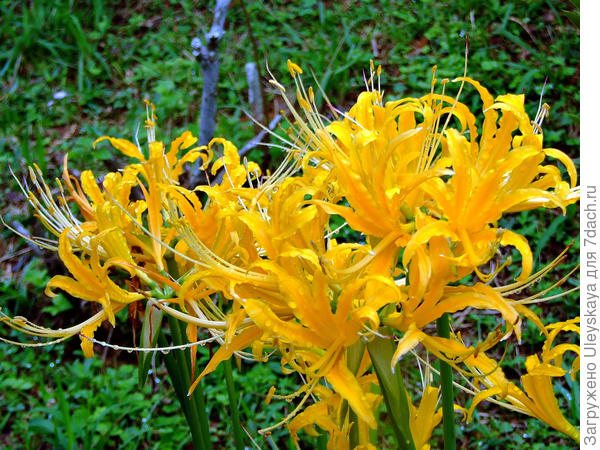

Licoris golden.
Licoris golden (Lycoris aurea) - up to 60 cm high, 20 cm wide. Tubular flowers, bright yellow, 10 cm in diameter, collected in 5-6, bloom from late spring - in summer. Blooms in a leafless state; preferably an open, sunny place with well-drained fertile soils, does not tolerate waterlogging.

